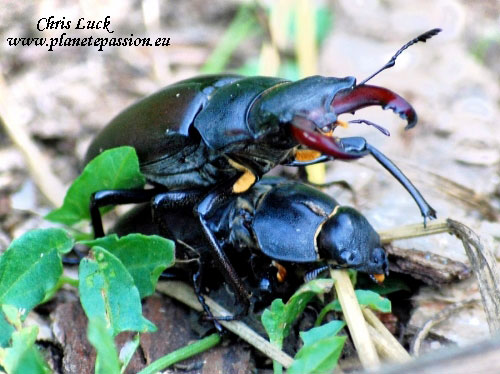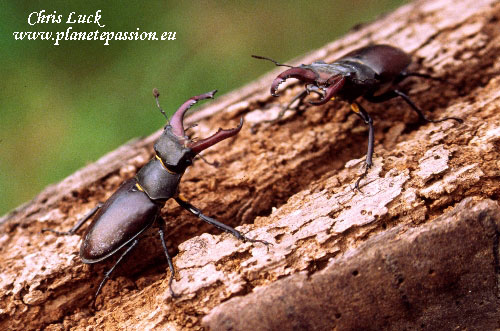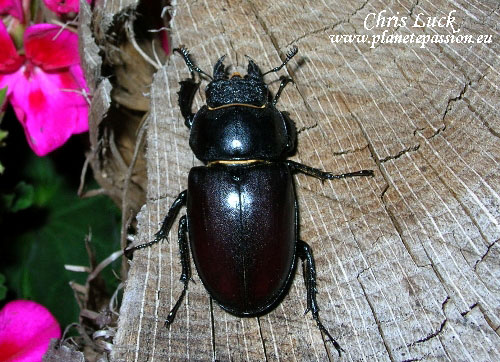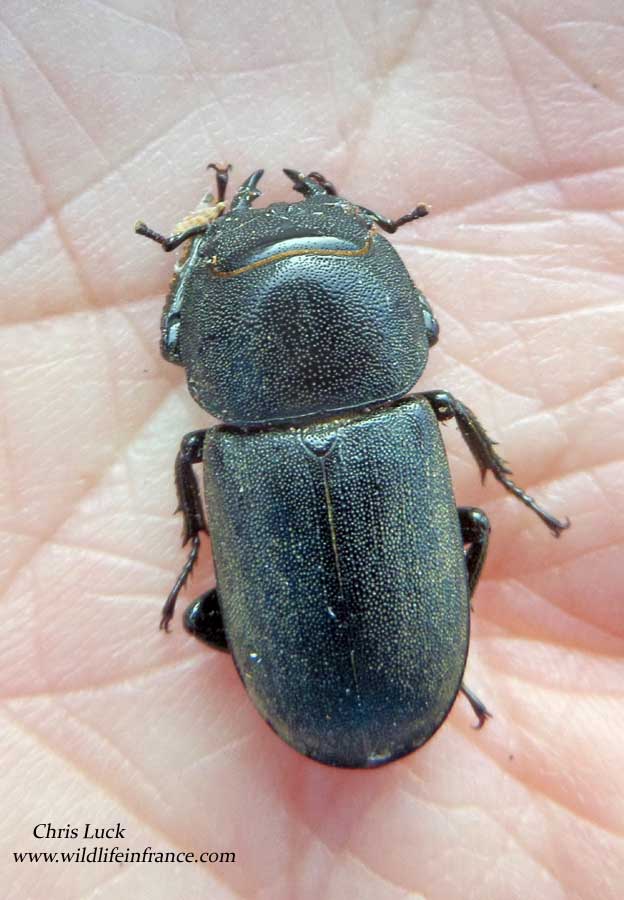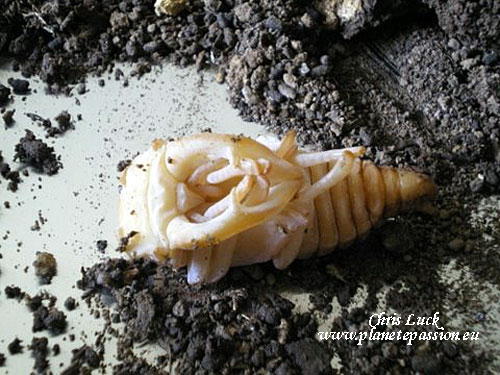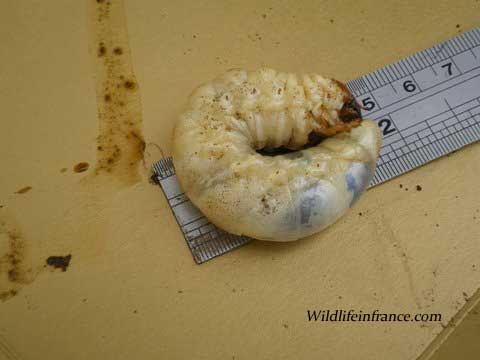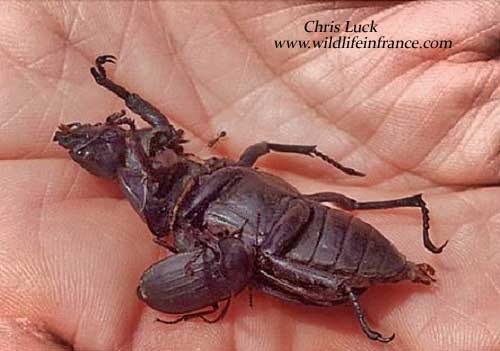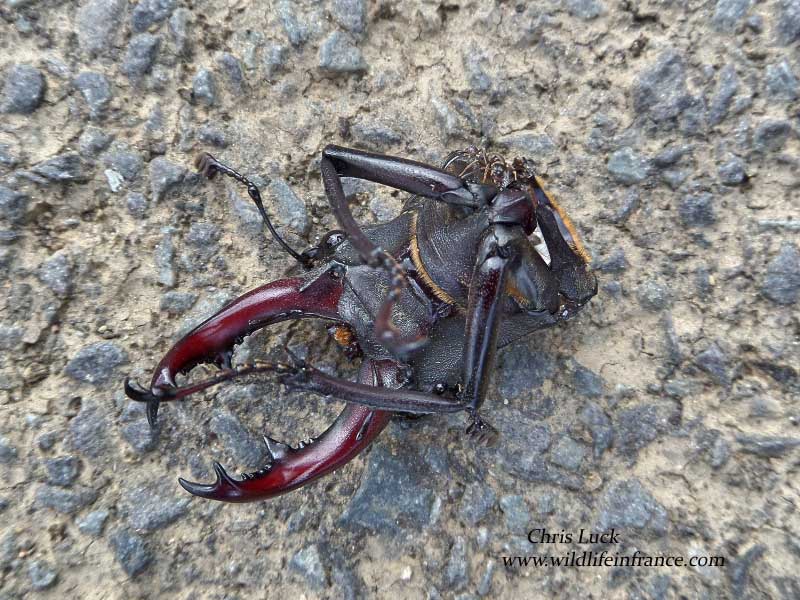Stag beetle
Lucanus Cervus
Lucane cerf-volant
Lucanus Cervus is the largest European beetle, the Stag Beetle, or as they are called in French “Le Lucane Cerf Volant”. From around the beginning of June on warm evenings in France, often when humidity is high, people will start to hear the drone of the males as they make their clumsy and apparently impossible flights to seek out the females. The females don’t fly as often as the males, (if at all), tending to spend more of their time on the ground waiting for the males to find them attracted by their pheromones. Sometimes more than one male will arrive having been attracted by a females pheromones, the males then proceed to fight for the right to mate the female using their large antlers to wrestle with. Happily this rarely causes any harm as the weakest backs down and retreats from battle.
Most people I speak to seem to be at least a little bit fascinated by these spectacular creatures, particularly the males which have the large antler like mandibles and although these look rather threatening it is the female which is about half the size of the male and lacks the antlers who is more likely to give you a bit of a pinch if you pick her up; she is equipped with very powerful and sharp mandibles like clippers. Should you need to move one out of harms way, from a road, a path or even from your house, it is best to nudge them from behind into a tin, plastic container or simply on to your hand and tip them out under a bush or by a tree, making sure that they don’t end up on their back.
There can be a possibility of mistaking both male and female Lesser Stag beetles for a female Stag beetle but an obvious difference is that Lesser stag beetles are completely matt black with no shades of brown.
After copulation has taken place the female Stag beetle lays her eggs on what is to be the food medium for the larvae. This is old, rotten wood lying on the ground or at the base of dead or partly dead trees, and although there is a preference for oak or chestnut other timbers will be used. The wood needs to be on or partially on the ground to remain moist and decomposing. The Stag beetle larvae, which can grow to a staggering 8cm and can also “nip”, live in the rotting wood for many years. The actual length of the life cycle is quite variable, possibly dependent on temperatures and can be 4, 5, 6, 7 or even 8 years resulting in a kind of insurance policy against bad years as well as providing genetic variety. They are classed as saproxylophages, creatures which live in dead and rotting wood.
The Lesser Stag beetle, Dorcus paralellapipidus, has several differences in behaviour and development. They also rely on dead wood for a large part of their life cycle but rather than laying their eggs in rotting wood underground, they use wood and tree stumps above the ground. Females lay their eggs in rotting wood above ground and the larvae only take 1-2 years to develop and unlike stag beetles the adults don’t necessarily die at the end of the season and can live for up to 2 years spending winter in sheltered places. Nutrition for adults seems to be taken in liquid form from various sugary plant or tree excretions.
In most of the regions of France the Stag Beetle and the Lesser Stag beetle are doing reasonably well compared to many other insects, although overall in Europe they have declined and are now scarce in many parts of their previous range. Jean Henri Fabre, 1823–1915, French entomologist and author, reported that he easily filled a top hat with Stag beetles in one evening, which is unimaginable now even if you took a month where they are plentiful. Land clearance for agriculture is clearly one reason for the decline as is the increase in coniferous commercial woodland, other likely reasons are that we are probably just to tidy in urban and peri-urban environments, very little wood is left lying around to rot in parks and gardens, wood used for fence posts and the like is usually chemically treated, old trees are removed including the stumps and roots before completing their full life cycle and hedgerows which contain a large quantity of dead wood and debris at their base have also been removed. As stated above, we are fortunate in many parts of France which may be due in part to the rotational coppicing for firewood on a 20 to 30 year cycle which leaves quantities of dead wood and stumps in situ. Never the less every effort should be made to maintain this species in its continuing strongholds.
If you have veteran trees, try to leave them standing, or if you do need to cut down trees, try to leave the stumps in place to decay. Try to maintain a native species hedge if you have one, or if you have land consider planting a native species hedge. Make a log pile in a corner of your garden, perhaps by sparing a few lengths of oak from your firewood delivery if you have one and add to it each year allowing it to slowly rot; the addition of bark, wood chippings and sawdust will be useful, it is important that the bottom remains in contact with or slightly buried in the soil. This can be discreetly hidden behind a bush or shrub or made into a decorative garden feature for those with an artistic leaning. You could perhaps also empty all your grass cuttings in a heap alongside your “wood pile”.
All of these measures will benefit many other species and encourage biodiversity and add to the buzz in your garden. It should be made absolutely clear the larvae of both species of Stag beetle don't pose any threat whatsoever to dry seasoned wood in your buildings; only moist decomposing wood will be used outside on the ground.
